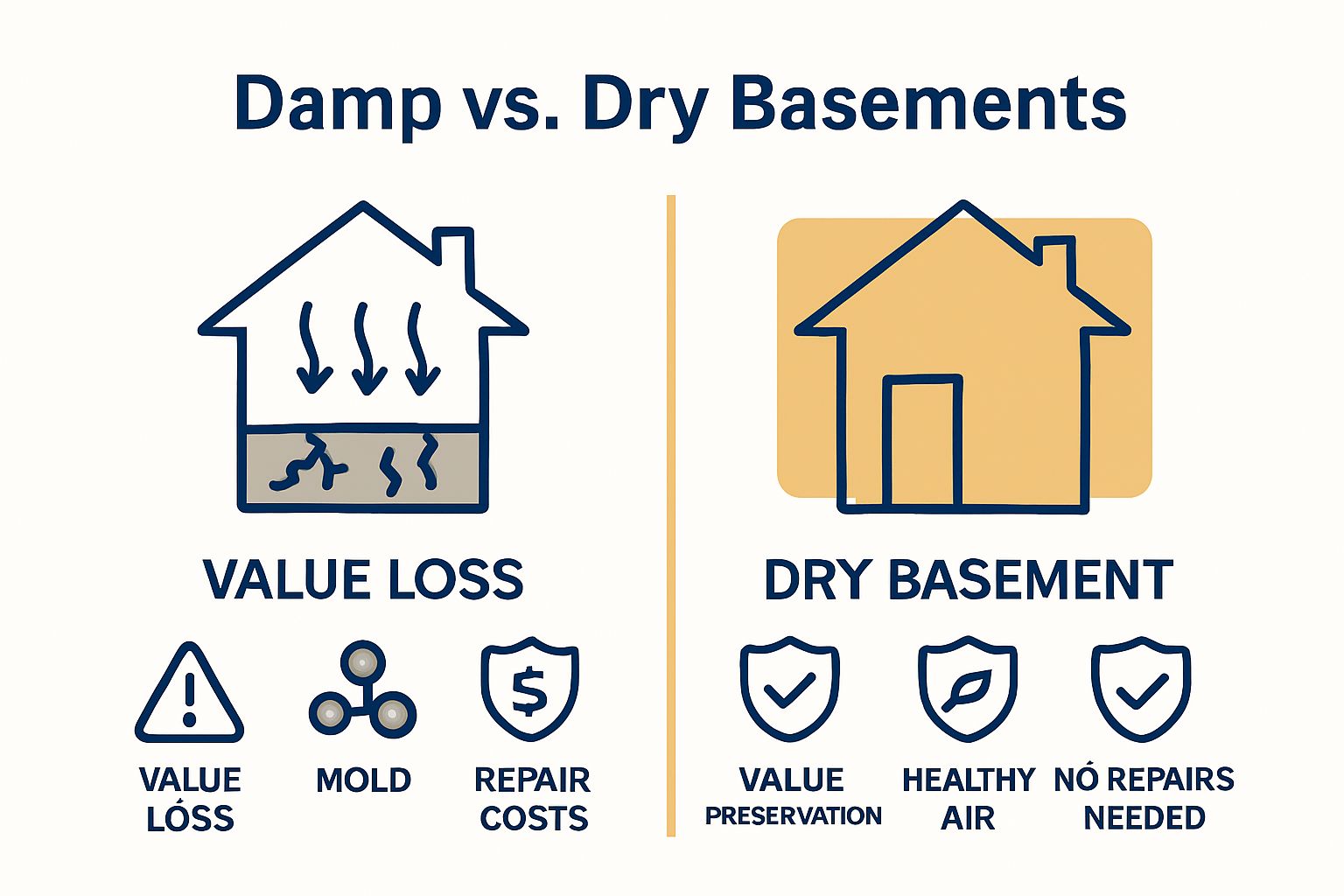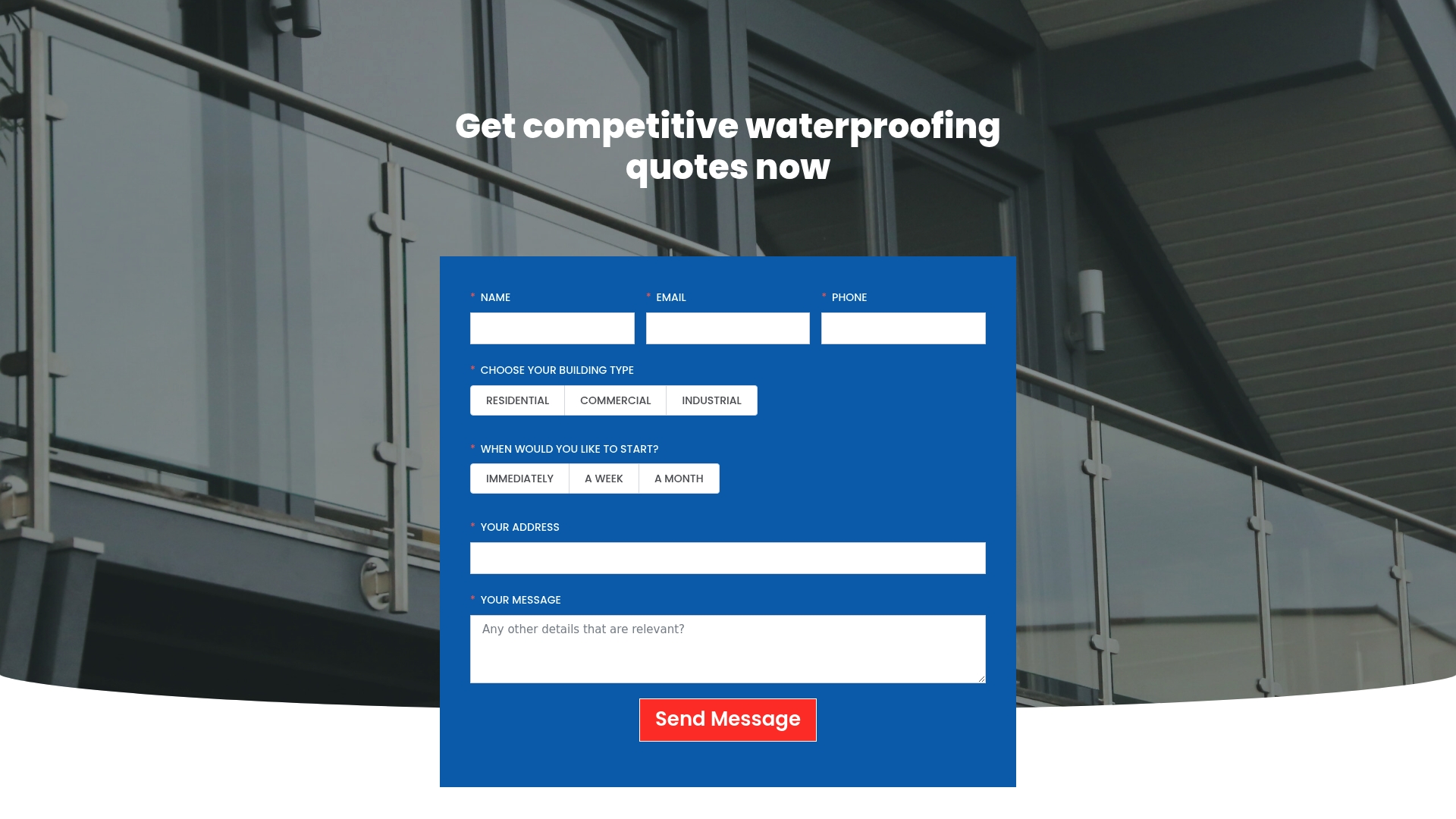Basements are often seen as the ultimate storage space or even an extra living room, but they face a hidden threat under the surface. Water can slip through the smallest cracks and cause silent destruction, and statistics show that up to 60 percent of homes have wet basements at some point. Most people assume a little dampness is just part of the package, yet proper basement waterproofing can actually transform these areas into safe, healthy, and valuable parts of any property.
Table of Contents
- What Is Basement Waterproofing?
- Why Basement Waterproofing Matters For Property Owners
- How Basement Waterproofing Works: Key Concepts Explained
- The Long-Term Benefits Of Waterproofing Your Basement
- Practical Applications And Real-World Examples Of Waterproofing
Quick Summary
| Takeaway | Explanation |
|---|---|
| Basement waterproofing is essential. | It prevents water damage and preserves the structural integrity of both residential and commercial buildings. |
| Invest in professional waterproofing services. | Professional techniques address vulnerabilities and ensure comprehensive protection against moisture intrusion. |
| Avoid costly water-related repairs. | Proactive waterproofing mitigates financial risks associated with structural deterioration and restoration expenses. |
| Create healthier indoor environments. | Effective waterproofing reduces mould and mildew, ensuring better air quality and health safety for occupants. |
| Maximise usable basement space. | Waterproofing transforms damp areas into valuable, functional spaces that enhance property value and livability. |
What is Basement Waterproofing?
Basement waterproofing represents a crucial structural protection strategy designed to prevent moisture intrusion and water damage within below-ground living spaces. This comprehensive technique involves multiple methods and technologies engineered to create a robust barrier against water penetration, ultimately safeguarding the structural integrity of residential and commercial buildings.
The Core Concept of Water Protection
At its fundamental level, basement waterproofing is about creating an impenetrable shield that stops water from entering underground spaces through walls, floors, and foundations. Water intrusion can occur through various pathways, including microscopic concrete cracks, porous building materials, structural joints, and natural groundwater pressure. Learn more about basement waterproofing techniques to understand the comprehensive approaches professionals use.
The primary objectives of basement waterproofing include:
- Preventing structural deterioration caused by persistent moisture
- Protecting valuable property and belongings from water damage
- Maintaining a healthy indoor environment by reducing mould and mildew growth
- Preserving the building’s overall structural foundation
Technical Mechanisms of Water Resistance
Professional waterproofing involves sophisticated techniques that go beyond simple surface treatments. These methods typically include:
- Interior sealant applications that create a water-resistant membrane
- Exterior drainage systems that redirect groundwater away from foundations
- Specialized waterproof coatings that penetrate and reinforce concrete structures
Understanding basement waterproofing requires recognising that water can enter through multiple channels. Hydrostatic pressure from surrounding soil, capillary action through porous materials, and structural micro fractures all represent potential water entry points. Professional waterproofing addresses these vulnerabilities through comprehensive, multi-layered protection strategies that combine mechanical, chemical, and architectural solutions.
By implementing robust waterproofing measures, property owners can significantly reduce the risk of costly water-related damage and preserve the long-term value and safety of their underground spaces.
Why Basement Waterproofing Matters for Property Owners
Basement waterproofing transcends mere maintenance and represents a critical investment in property protection, structural integrity, and long-term financial security. Property owners who understand the comprehensive implications of water damage prevention position themselves to safeguard significant financial assets and ensure optimal building performance. Learn more about why basement waterproofing is crucial to comprehend its broader significance.
Financial Implications of Water Damage
Water damage can result in substantial economic consequences for property owners. Uncontrolled moisture infiltration leads to progressive structural deterioration that can compromise entire building foundations. The potential financial impact includes:
- Structural repair costs ranging from thousands to hundreds of thousands of rand
- Decreased property market value due to water damage history
- Potential complete loss of basement utility and functionality
- Increased insurance premiums or potential coverage denial
Professional waterproofing represents a proactive investment that mitigates these substantial financial risks by addressing potential water intrusion before extensive damage occurs.
Health and Environmental Considerations
Beyond financial concerns, basement waterproofing plays a pivotal role in maintaining healthy living environments. Persistent moisture creates ideal conditions for mould, mildew, and bacterial growth, which can generate significant health risks for occupants. Uncontrolled humidity levels contribute to respiratory issues, allergic reactions, and potential long-term health complications.
Water-resistant basement environments protect not just the physical structure but also the inhabitants’ well-being. By eliminating moisture pathways and creating a controlled indoor environment, property owners can effectively reduce potential health hazards associated with damp, poorly maintained underground spaces.
The strategic implementation of comprehensive waterproofing solutions transforms basement spaces from potential liability zones into valuable, safe, and functional areas of residential or commercial properties. Property owners who prioritize proactive water protection demonstrate responsible asset management and commitment to long-term structural preservation.
How Basement Waterproofing Works: Key Concepts Explained
Basement waterproofing operates through sophisticated, multilayered strategies designed to prevent moisture penetration and protect underground structural environments. Explore the nuanced techniques of waterproofing to understand the complexity behind effective water resistance.
Moisture Prevention Mechanisms
Water intrusion prevention involves comprehensive approaches targeting different potential entry points. Professional waterproofing experts recognize that effective protection requires understanding the complex interactions between building structures, soil conditions, and water dynamics. These mechanisms typically address:
- Surface water management strategies
- Underground hydrostatic pressure control
- Structural membrane reinforcement
- Drainage system optimization
The fundamental principle underlying basement waterproofing involves creating multiple defensive barriers that collectively repel and redirect water away from critical structural zones. This means developing integrated systems that work synergistically to maintain a dry, stable underground environment.
Technical Waterproofing Approaches
Professional waterproofing encompasses several sophisticated technical strategies. Exterior waterproofing methods focus on preventing water from reaching foundation walls, while interior techniques concentrate on managing moisture that might penetrate initial barriers.
To help clarify the differences between various basement waterproofing approaches, the table below compares exterior and interior methods, outlining their focus, main techniques, and targeted vulnerabilities.
| Approach | Focus Area | Main Techniques | Targeted Vulnerabilities |
|---|---|---|---|
| Exterior Waterproofing | Outside of foundation | Waterproof membranes, perimeter drainage, soil grading | Hydrostatic pressure, groundwater ingress |
| Interior Waterproofing | Basement interior | Sealant coatings, chemical injections, interior drainage systems | Capillary action, minor cracks, condensation |
| Combined Approach | Integrated | Use of both exterior and interior strategies | Multiple entry points, severe water issues |
| According to building technology experts, key approaches include: |
- Applying specialized waterproof membranes
- Installing perimeter drainage systems
- Implementing chemical sealants and injections
- Creating slope gradients around building foundations
Each technique addresses specific vulnerabilities in building structures, recognizing that water infiltration can occur through microscopic cracks, porous materials, and complex geological interactions. Successful waterproofing requires a holistic understanding of how water moves, accumulates, and potentially damages underground spaces.
The most effective waterproofing strategies combine multiple techniques, creating a comprehensive protection system that adapts to unique property characteristics and environmental challenges. By understanding these intricate mechanisms, property owners can develop robust defence strategies against potential water-related structural risks.
The Long-term Benefits of Waterproofing Your Basement
Basement waterproofing represents a strategic investment that delivers substantial long-term advantages beyond immediate moisture protection. Discover why waterproofing is a must for property owners to understand its comprehensive value proposition.
Structural Preservation and Asset Value
Professional waterproofing directly contributes to maintaining and potentially increasing property value by preventing progressive structural degradation. According to building durability research, proper waterproofing significantly enhances building lifespan by mitigating water-related deterioration. The long-term structural benefits include:
- Prevention of concrete erosion and reinforcement corrosion
- Minimisation of foundation settlement and structural shifts
- Reduction of potential structural repair expenses
- Maintenance of optimal building integrity over decades
Property owners who invest in comprehensive waterproofing strategies effectively shield their assets from cumulative water damage risks, preserving both structural soundness and market valuation.
Enhanced Living Environment and Functional Space
Waterproofing transforms basement areas from potentially damp, unusable spaces into valuable, functional extensions of residential or commercial properties. By creating controlled, moisture-resistant environments, property owners unlock significant additional utility and living space potential. Key environmental advantages encompass:
- Elimination of musty odours and dampness
- Prevention of mould and mildew proliferation
- Creation of safe, habitable underground areas
- Improved indoor air quality and respiratory health
The strategic implementation of waterproofing solutions enables property owners to maximise their available square meterage, converting potentially problematic basement areas into productive, comfortable spaces that add tangible value to the overall property.
The following table summarises the long-term benefits of basement waterproofing, highlighting how each key advantage impacts both the property and its occupants.
| Benefit | Impact on Property | Impact on Occupants |
|---|---|---|
| Structural preservation | Prevents foundation damage, reduces repair costs | Ensures building safety |
| Asset value retention | Maintains or increases resale value | Provides financial security |
| Enhanced living environment | Eliminates dampness and odours | Improves air quality, comfort |
| Increased functional space | Converts basement into usable area | Expands living or storage options |
| Mould and mildew prevention | Preserves building materials | Reduces respiratory health risks |
Ultimately, basement waterproofing transcends simple maintenance. It represents a forward-thinking approach to property management that protects financial investments, ensures structural longevity, and creates healthier, more functional living environments.
Practical Applications and Real-world Examples of Waterproofing
Waterproofing solutions extend far beyond theoretical concepts, representing critical protective strategies across diverse property types and environmental conditions. Learn more about essential waterproofing applications to understand their comprehensive practical significance.
Residential Waterproofing Scenarios
Residential waterproofing involves targeted interventions addressing unique challenges in home environments. Different residential structures require specialised approaches based on architectural design, geological conditions, and specific moisture vulnerability points. Typical residential waterproofing applications include:
- Foundation wall membrane treatments
- Basement floor sealant applications
- Crawl space moisture barrier installations
- Exterior perimeter drainage system implementations
Each residential scenario demands a nuanced understanding of potential water intrusion pathways, requiring professionals to develop customised solutions that protect structural integrity and living spaces from moisture-related deterioration.
Commercial and Industrial Waterproofing Strategies
Commercial and industrial environments present more complex waterproofing challenges, often involving larger surface areas and more sophisticated infrastructure. These applications require robust, engineered solutions capable of withstanding significant environmental stress. According to construction engineering research, critical commercial waterproofing approaches encompass:
- Underground parking structure membrane systems
- Multi-level building envelope protection techniques
- High-performance chemical injection methodologies
- Advanced drainage and water redirection infrastructure
Professional waterproofing in commercial settings goes beyond simple moisture prevention, integrating comprehensive risk management strategies that protect substantial financial investments and ensure operational continuity.
The practical application of waterproofing techniques represents a sophisticated intersection of materials science, architectural engineering, and proactive maintenance. By understanding specific environmental challenges and implementing targeted protective measures, property owners can effectively mitigate water-related risks across diverse structural contexts.
Protect Your Property From Costly Water Damage – Take Action With Pro Waterproofing
Worried about hidden moisture, structural deterioration or rising repair costs mentioned in the article? Basement water issues can quickly turn your home’s greatest asset into a source of stress and expensive problems. Damp walls, mould, or a musty smell are signs you need more than reactive fixes – you need a trusted waterproofing solution rooted in expertise. At Pro Waterproofing, our team understands the pain points property owners face, from persistent basement leaks to the challenge of finding contractors with proven experience and reliable warranties.
Let South Africa’s waterproofing specialists help you protect your investment, health and peace of mind. Visit our main site and explore our range of expertly delivered services. For more information on how to stop water problems before they escalate, browse our Uncategorized – Pro Waterproofing resource. Do not wait for damage to grow – request your quote today and enjoy a dry, safe basement that adds real value to your property.
Frequently Asked Questions
What are the key benefits of basement waterproofing?
Basement waterproofing provides structural preservation, prevents water damage, enhances indoor air quality, and increases overall property value by maintaining dry, functional underground spaces.
How does basement waterproofing protect against health risks?
By preventing moisture intrusion, basement waterproofing reduces the growth of mould, mildew, and bacteria, which can pose significant health risks, including respiratory issues and allergic reactions for occupants.
What techniques are commonly used in basement waterproofing?
Common techniques include the application of interior sealants, exterior drainage systems, waterproof coatings, and reinforcement of structural membranes, each targeting specific vulnerabilities to water intrusion.
How does waterproofing impact a property’s market value?
Effective basement waterproofing helps maintain or increase a property’s market value by preventing structural deterioration due to water damage, thereby showcasing a well-maintained and desirable property for potential buyers.




